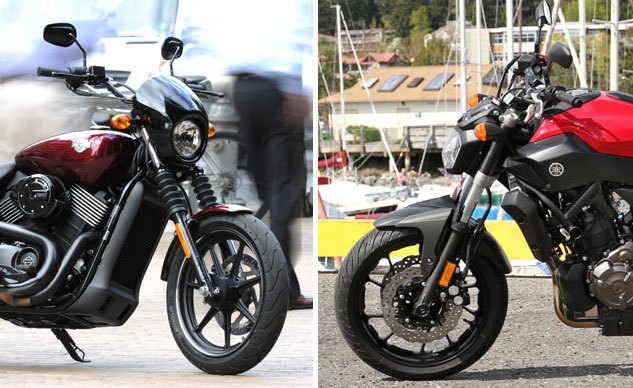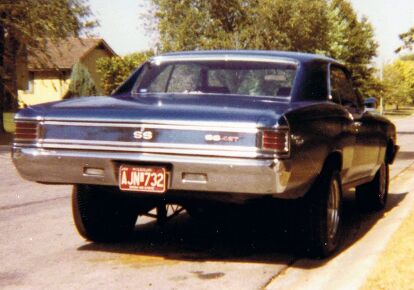Whatever! - Nature, Nurture or Cruiser?
How do you know if you're a sportbike or a cruiser person anyway?
So, we were kicking around what bikes to compare the new Harley-Davidson Street 750 to, when I said how about the new Yamaha FZ-07? One looks a bit more “cruiser” and the other more “sportbike,” but they’re both new twin-cylinder models in the same price range, with mostly upright ergonomics, aimed at beginners but suitable for all open-minded riders. Now that the violent stage of the motorcycle culture wars has pretty much ended, how are you supposed to know if you’re a cruiser or a sportbike person, anyway, if you’re just getting started?
Well, I know why I wanted a sportbike when I was growing up in the Midwest: I’d been driving around in a Triumph Spitfire, pretending to be a real sportscar guy by revving the thing up to redline all the time, but I was way more enthusiastic than the Spitfire’s 1500cc four-banger. The tiny Triumph looked like it would do 150 mph, and that was good enough for 17-year old me. Who knew from valve float? Who knew from valves, really? By 5000 rpm in fourth gear, it sounded like all hell was breaking loose under the “bonnet,” and then somebody would blow past in their mom’s Pontiac Safari wagon. It began to dawn that things were not always as they appeared to be …
The Spitfire continued its mission of enlightenment with the next unsuspecting youth, and I got a ’67 Chevelle with a breathed-on 396 and a four-speed. Compared to the Triumph, it was like driving the world’s fastest dump truck. Luckily the roads were mostly straight. When things were good, though, and the dual-point distributor and Holley double-pumper and valve lash were all perfectly adjusted, the old big-block would nudge the tach needle up just beyond 6000 rpm (whether the rear tires were with us or not), sending up a glorious racket. Pontiac Safari wagons were no longer a problem. The Chevelle got me really interested in rpm, started me reading Hot Rod and things, and made me crave even more revolutions. RPM is a progressive disease; I needed an increasing dose.
I was at the drugstore newsstand when the cover of some streetbike rag caught me eye, with a big cover photo of some new motorcycle’s instruments: the tach didn’t turn red `til 11! Impossible!! Sold! Even though the only guys I knew with motorcycles were Harley guys, I was a confirmed Japanese-bike guy as of that moment, and I wanted one. The “cruiser” as we now know hadn’t been invented yet: There were Harleys and there were Japanese bikes. Becoming a Harley guy, which later segued into being a cruiser guy, never really entered my mind. Harleys in those days were both slow and déclassé.
Yamaha was the first to breach the great divide, with the 1981 Virago, the first Japanese V-twin. The Harley crowd had managed to contain its contempt until that point, but the Virago was the last straw and nearly ignited WW3 – in spite of the fact that it was more Ducati-like than Harleyesque, complete with a monoshock rear end and overhead cams. (What’s a Ducati?)
Once the camel nose was in the tent and the initial furor died down a bit, Yamaha did de-sportify and tart up the thing as if that had been the plan all along, adding twin shocks, a really low price tag and more shiny chrome to appeal to the Harley crowd, much like one appeals to a large-mouth bass. It worked – not on the Harley guys, but on the wannabes who didn’t know any better.
Soon, Japanese cruisers were even more popular than other Japanese bikes had been, though when I later broke into the industry, we were to refer to them as “customs” so as not to encourage any relationship with the 1980 Al Pacino film Cruising. (What’s a homosexual?) Then as now, the PR people were really on the ball! After the Virago broke down the wall and created an entirely new market for the Japanese, we were soon inundated with Shadows, Intruders, Vulcans, Volusias, Nomads, LowSlingers, Furys, Boulevards, etc.
Now that all other things are equal, i.e., price, reliability and depth of social stigma, how do you determine if you’re a cruiser guy or a sportbike one? Here’s my Unified Theory:
#1 Literacy. I became a sportbike nut from reading magazines from California while the other nabobs were hanging out at the pool hall. I had no idea what a first-gear corner or a canyon was, but I knew I needed a motorcycle that could handle them. The big magazine testers looked down their noses at cruisers. None of them revved to 11,000 rpm, and none of them gave you an excuse to appear in public in a tight red leather onesie. Over-educated eggheads, particularly engineer types, gravitate toward sportbikes.
#2 Practicality. Kevin Cameron asks, who do you want to help you fix a machine when it’s broken and you need it now? An engineer or a farmer? Probably the farmer. While I was reading about canyons and first-gear corners, the cruiser guys around me (some of who were one generation removed from being farmers) had already noticed there weren’t either of those in our part of the world. And the more comfortable cruiser was a far better choice most of the time, especially on dirt roads. Blue-collar, hands-on, common-sense types lean cruiserward.
#3 Political Bent. I’ve always wanted to conduct a survey to correlate peoples’ politics with their motorcycle choice. You don’t see many sportbikes cruising around flying the Stars and Stripes, but you see plenty of flags on cruisers. Is patriotism the last refuge of the scoundrel, or just one more thing to have flapping in the breeze? Do cruiser riders track right politically? Does innate conservatism instruct them to preserve the past, while their sportbiking and dirt-tracking brethren all find it more natural to turn left? Sportbike nuts can’t wait for the next technical innovation, even if it doesn’t work. Five-valve heads. Anti-dive forks. Gear-driven cams! Every new crotch rocket gets a new gas tank. Meanwhile, Harley-Davidson dare not fool with the Fat Bob – still stamped out by the same machine in the York, PA, plant since the ’30s.
#4 Competitiveness. My rediscovered Facebook friend Mark Miller, one of two Americans who’ve won at the Isle of Man, says when he “goes warring” on his motorcycle, he wants the best power, brakes, cornering clearance and traction he can get. Cruiser guys aren’t really having any of that. When seen in groups, they seem to mostly want to fly in formation at the speed of the slowest bike; it’s almost like socialism, which is ironic given #3. Cruiser guys do their fighting once the bikes are parked, and mostly vicariously through Sons of Anarchy and other terrible TV shows. Sportbike guys are about winning; cruiser guys are more about community.
#5 El sexo! If I was the opposite sex, I’d go for the flexible daredevil on the sportbike every time. But the passenger seat on any cruiser is way more accessible and wider, minimizing the size of any butt that’s on it – and so the typical potential female passenger will go for the cruiser every time, all other things being equal. Most men won’t ride on back at all for fear of being associated with the 1980 Al Pacino film Cruising. The sporty biker’s motorcycle is a high-tech toy built for speed; the cruiser’s machine is a lifestyle accessory enhanced for social interaction and for attracting a mate via colorful skull displays and chrome plumage. Its rider is more likely to pass on his DNA, possibly in a Port-a-John.
Anyway, none of it matters really, because after you reach a certain age and have ridden all kinds of bikes, you realize there’s a seat for every ass (in the words of the great Nigel Gale), plenty of circumstances that favor one style of bike over the other, and that to every motorcycle there is a season turn, turn, turn.
I think Harley and the cruisers blinked first, though – first with the V-Rod, and now with the new Street 750 complete with overhead cams, 8000-rpm revvability and super-compact dimensions. All sorts of cruisers, in fact, are way more fun to ride than the early Japanese efforts: your Suzuki M109R, your Star Stryker, your Ducati Diavel, Triumph Thunderbird …
Maybe the great moto harmonic convergence is near? And maybe peace will break out in the Middle East.









































Comments
Join the conversation
Great column, John, but some of these pics have altered my view of humanity forever...
I longed for a cruiser for years. But like has been said they are like lazy boys not a bad thing cause I still love the looks. But the performance of a sport bike is top notch so I opted out and bought a Star VMAX 1700 for the best of both worlds plenty of options out there that are neither sport or cruiser.